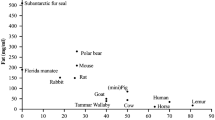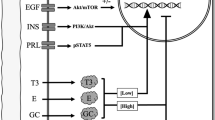Abstract
Theories for the origin of milk have been recorded since the time of Ancient Greeks. In those times it was believed that milk was derived from special vessels that connected the uterus to the breasts. The “chyle theory” on the origin of milk was another prominent theory which persisted well into the nineteenth century before the realisation that milk components were derived from blood and some milk constituents were actually synthesized within the breasts. The demonstration that milk ejection was the expulsion of milk that had already been secreted and that milk secretion was a separate continuous process, set the background for the development for the current understanding of milk synthesis and secretion. Today we know that there are two stages in the initiation of lactation- secretory differentiation and secretory activation. Secretory differentiation represents the stage of pregnancy when the mammary epithelial cells differentiate into lactocytes with the capacity to synthesize unique milk constituents such as lactose. This process requires the presence of a ‘lactogenic hormone complex’ of the reproductive hormones, estrogen, progesterone, prolactin and some metabolic hormones. Secretory activation on the other hand, is the initiation of copious milk secretion and is associated with major changes in the concentrations of many milk constituents. The withdrawal of progesterone triggers the onset of secretory activation but prolactin, insulin and cortisol must also be present. This review describes the works of pioneers that have led to our current understanding of the biochemical and endocrinological processes involved in the initiation of human lactation.





Similar content being viewed by others
Abbreviations
- CNS:
-
central nervous system
- RQ:
-
respiratory quotient
- JAK:
-
Janus kinase
- STAT:
-
signal transducer and activator of transcription
References
Folley SJ. Symposium on lactogenesis: chairman’s introduction. In: Reynolds M, Folley SJ, editors. Lactogenesis: the initiation of milk secretion at parturition. Philadelphia: Pennsylvania Press; 1969. p. 1–3.
Folley SJ. The physiology and biochemistry of lactation. Edinburgh: Oliver and Boyd; 1956.
Hartmann PE. Changes in the composition and yield of the mammary secretion of cows during the initiation of lactation. J Endocrinol 1973;59(2):231–47.
Hartmann PE, Trevethan P, Shelton JN. Progesterone and estrogen and the initiation of lactation in ewes. J Endocrinol 1973;59(2):249–59.
Fleet IR, Goode JA, Hamon MH, Laurie MS, Linzell JL, Peaker M. Secretory activity of goat mammary glands during pregnancy and the onset of lactation. J Physiol 1975;251(3):763–73.
Neville MC. Determinants of milk volume and composition. A. Lactogenesis in women: a cascade of events revealed by milk composition. In: Jensen RG, editor. Handbook of milk composition. San Diego: Academic; 1995. p. 87–98.
Anderson SM, Rudolph MC, McManaman JL, Neville MC. Key stages in mammary gland development. Secretory activation in the mammary gland: it’s not just about milk protein synthesis! Breast Cancer Res 2007;9(1):204.
Cowie AT. The hormonal control of milk secretion. In: Kon SK, Cowie AT, editors. Milk: the mammary gland and its secretion. London: Academic; 1961. p. 163–203.
Cowie AT, Forsyth IA, Hart IC. Hormonal control of lactation. Monogr Endocrinol 1980;15:I–XIV, 1–275.
Folley SJ. Lactation. In: Parkes AS, editor. Marshall’s physiology of reproduction. 3rd ed. London: Longmans; 1952. p. 525–649.
Calder R. Leonardo and the age of the eye. London: Heinemann; 1970.
Cooper AP. 1768–1841, On the anatomy of the breast. London: Longman, Orme, Green, Brown, and Longmans; 1840.
Ramsay DT, Kent JC, Hartmann RA, Hartmann PE. Anatomy of the lactating human breast redefined with ultrasound imaging. J Anat 2005;206(6):525–34.
Glencross BD, Mullan BP, Tuckey RC, Hartmann PE. A simplification of the deuterium oxide dilution technique using FT-IR analysis of plasma, for estimating piglet milk intake. Aust J Agric Res 1997;48(8):1099–1104.
Gaines WL. A contribution to the physiology of lactation. Am J Physiol 1915;38(2):285–312.
Gaines WL, Sanmann FP. The quantity of milk present in the udder of the cow at milking time. Am J Physiol 1927;80(3):691–701.
Ely F, Petersen WE. Factors involved in the ejection of milk. J Dairy Sci 1941;24(3):211–23.
Richardson KC. Contractile tissues in the mammary gland, with special reference to myoepithelium in the goat. Proc R Soc Lond Ser B Biol Sci 1949;136(882):30–45.
Gunther M. Lactation in women. Can Med Assoc J 1942;47(5):410–14.
Newton M, Newton NR. The let-down reflex in human lactation. J Pediatr 1948;33(6):698–704.
Shennan DB, Peaker M. Transport of milk constituents by the mammary gland. Physiol Rev 2000;80(3):925–51.
Neville MC, Allen JC, Watters C. The mechanisms of milk secretion. In: Neville MC, Neifert MR, editors. Lactation: physiology, nutrition, and breast-feeding. New York: Plenum; 1983. p. 49–92.
Fetherston CM, Lai CT, Hartmann PE. Relationships between symptoms and changes in breast physiology during lactation mastitis. Breastfeed Med 2006;1(3):136–45.
Kulski JK, Hartmann PE. Changes in human milk composition during the initiation of lactation. Aust J Exp Biol Med Sci 1981;59(1):101–14.
Prentice A, Paul A, Prentice A, Black A, Cole T, Whitehead R. Cross-cultural differences in lactational performance. In: Hamosh M, Goldman AS, editors. Human lactation 2: maternal and environmental factors. New York: Plenum; 1986. p. 13–44.
Lyons W. The direct mammotrophic action of lactogenic hormone. Proc Soc Exp Biol Med 1942;51:308–11.
Meites J, Turner CW. Studies concerning the induction and maintenance of lactation. I. The mechanism controlling the initiation of lactation at parturition. Res Bull Mo Agric Exp Stn 1948;415:1–65.
Meites J, Turner CW. Studies concerning the induction and maintenance of lactation. II. The normal maintenance and experimental inhibition and augmentation of lactation. Res Bull Mo Agric Exp Stn 1948;416:1–36.
Popjak G, Beeckmans M-L. Synthesis of cholesterol and fatty acids in fetuses and in mammary glands of pregnant rabbits. Appendix 1. Water bath suitable for the maintenance of temperature to within. Biochem J 1950;46(5):547–61.
Balmain JH, Folley SJ, Glascock RF. Relative utilization of glucose and acetate carbon for lipogenesis by mammary-gland slices, studied with tritium, 13C and 14C. Biochem J 1954;56(2):234–9.
Folley SJ, Greenbaum AL. Changes in the arginase and alkaline phosphatase contents of the mammary gland and liver of the rat during pregnancy, lactation and mammary involution. Biochem J 1947;41(2):261–9.
Folley SJ, French TH. The intermediary metabolism of the mammary gland; respiration and acid production of mammary tissue during pregnancy, lactation and involution in the rat. Biochem J 1949;45(3):270–5.
Baldwin RL, Milligan LP. Enzymatic changes associated with the initiation and maintenance of lactation in the rat. J Biol Chem 1966;241(9):2058–66.
Baldwin RL. Enzymic and metabolic changes in mammary tissue at lactogenesis. In: Reynolds M, Folley SJ, editors. Lactogenesis: the initiation of milk secretion at parturition. Philadelphia: University of Pennsylvania Press; 1969. p. 85–95.
Denamur R. Changes in the ribonucleic acids of mammary cells at lactogenesis. In: Reynolds M, Folley SJ, editors. Lactogenesis: the initiation of milk secretion at parturition. Philadelphia: University of Pennsylvania Press; 1969. p. 53–64.
Kronfeld DS. Biosynthesis of milk constituents at lactogenesis. In: Reynolds M, Folley SJ, editors. Lactogenesis: the initiation of milk secretion at parturition. Philadelphia: University of Pennsylvania Press; 1969. p. 109–20.
Kronfeld DS, Ramberg CF. Whole animal studies using tracer kinetics. Proc Nutr Soc 1981;40(1):129–38.
Hardwick DC, Linzell JL. Some factors affecting milk secretion by the isolated perfused mammary gland. J Physiol 1960;154:547–71.
Hardwick DC, Linzell JL, Price SM. The effect of glucose and acetate on milk secretion by the perfused goat udder. Biochem J 1961;80:37–45.
Linzell JL. Transplantation of mammary glands. Nature 1960;188:596–8.
Cox DB, Kent JC, Casey TM, Owens RA, Hartmann PE. Breast growth and the urinary excretion of lactose during human pregnancy and early lactation: endocrine relationships. Exp Physiol 1999;84(2):421–34.
Saint L, Smith M, Hartmann PE. The yield and nutrient content of colostrum and milk of women from giving birth to 1 month post-partum. Br J Nutr 1984;52(1):87–95.
Arthur PG, Smith M, Hartmann PE. Milk lactose, citrate, and glucose as markers of lactogenesis in normal and diabetic women. J Pediatr Gastroenterol Nutr 1989;9(4):488–96.
Arthur PG, Kent JC, Hartmann PE. Microanalysis of the metabolic intermediates of lactose synthesis in human milk and plasma using bioluminescent methods. Anal Biochem 1989;176(2):449–56.
Folley SJ, Young FG. The effect of anterior pituitary extracts on established lactation in the cow. Proc R Soc Lond Ser B Biol Sci 1938;126(842):45–76.
Lyons WR. Hormonal synergism in mammary growth. Proc R Soc Lond Ser B Biol Sci 1958;149(936):303–25.
Cowie AT, Lyons WR. Mammogenesis and lactogenesis in hypophysectomized, ovariectomized, adrenalectomized rats. J Endocrinol 1959;19:29–32.
Meites J. Recent studies on the mechanisms controlling the initiation of lactation. Rev Can Biol 1954;13(4):359–70.
Forsyth IA. The endocrinology of lactation. In: Mepham TB, editor. Biochemistry of lactation. Amsterdam: Elsevier Science; 1983. p. 309–49.
Pasteels JL. Morphological and experimental research on prolactin secretion. Arch Biol (Liege) 1963;74:439–553.
Bryant GD, Greenwood FC. The concentrations of human prolactin in plasma measured by radioimmunoassay: experimental and physiological modifications. In: Wolstenholme GEW, Knight J, editors. Lactogenic hormones. Edinburgh: Churchill Livingstone; 1972. p. 197–206.
Neville MC, McFadden TB, Forsyth I. Hormonal regulation of mammary differentiation and milk secretion. J Mammary Gland Biol Neoplasia 2002;7(1):49–66.
Tucker HA. Hormones, mammary growth, and lactation: a 41-year perspective. J Dairy Sci 2000;83(4):874–84.
Freeman ME, Kanyicska B, Lerant A, Nagy G. Prolactin: structure, function, and regulation of secretion. Physiol Rev 2000;80(4):1523–631.
Gunther M. Infant feeding. London: Methuen; 1970.
Kuhn NJ. Progesterone withdrawal as the lactogenic trigger in the rat. J Endocrinol 1969;44(1):39–54.
Kuhn NJ. Specificity of progesterone inhibition of lactogenesis. J Endocrinol 1969;45(4):615–6.
Neifert MR, McDonough SL, Neville MC. Failure of lactogenesis associated with placental retention. Am J Obstet Gynecol 1981;140(4):477–8.
Kulski JK, Hartmann PE, Martin JD, Smith M. Effects of bromocriptine mesylate on the composition of the mammary secretion in non-breast-feeding women. Obstet Gynecol 1978;52(1):38–42.
Hale TW. Medications and mothers’ milk. 12st ed. Amarillo: Hale; 2006.
Burke CW, Roulet F. Increased exposure of tissues to cortisol in late pregnancy. Br Med J 1970;1(5697):657–9.
Florensa E, Harrison R, Johnson M, Youssefnejadian E. Plasma 20 alpha-dihydroprogesterone, progesterone and 17-hydroxyprogesterone in normal human pregnancy. Acta Endocrinol (Copenh) 1977;86(3):634–40.
Peterson R. Cortisol. In: Fuchs F, Klopper A, editors. Endocrinology of pregnancy. 2nd ed. New Yok, Evanston, London: Harper & Row; 1977. p. 157–176.
Cowie AT, Knaggs GS, Tindal JS, Turvey A. The milking stimulus and mammary growth in the goat. J Endocrinol 1968;40(2):243–52.
Brown RE. Relactation: an overview. Pediatrics 1977;60(1):116–20.
Nicholas KR, Hartmann PE. Progesterone control of the initiation of lactose synthesis in the rat. Aust J Biol Sci 1981;34(4):435–43.
Kulski JK, Smith M, Hartmann PE. Perinatal concentrations of progesterone, lactose and alpha-lactalbumin in the mammary secretion of women. J Endocrinol 1977;74(3):509–10.
Oliver G, Detmar M. The rediscovery of the lymphatic system: old and new insights into the development and biological function of the lymphatic vasculature. Genes Dev 2002;16:773–83.
Rendle-Short J, Rendle-Short M. The father of child care. Life of William Cadogan (1711–1797). Bristol: John Wright and Sons Ltd; 1966.
Acknowledgement
Our work is supported by Medela AG, Switzerland.
Author information
Authors and Affiliations
Corresponding author
Rights and permissions
About this article
Cite this article
Pang, W.W., Hartmann, P.E. Initiation of Human Lactation: Secretory Differentiation and Secretory Activation. J Mammary Gland Biol Neoplasia 12, 211–221 (2007). https://doi.org/10.1007/s10911-007-9054-4
Received:
Accepted:
Published:
Issue Date:
DOI: https://doi.org/10.1007/s10911-007-9054-4




